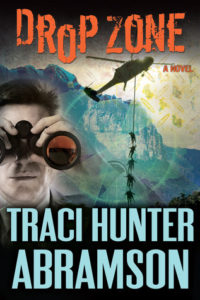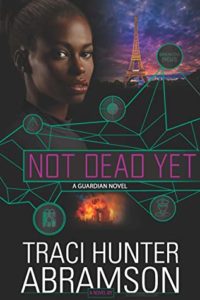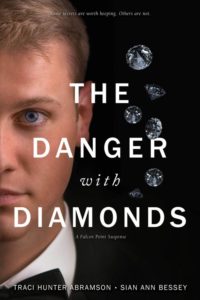 Guest post by Lisa Bolin Hawkins
Guest post by Lisa Bolin Hawkins
Traci Hunter Abramson has written going-on-40 books for the LDS market that combine elements of suspense, romance, and intelligence (as in both smarts and secret agents). One of her best abilities is taking incredible, or at least unusual, situations—a CIA agent meets a prince? a diplomat and a Navy SEAL have to hike out of a hostile country after their evac helicopter takes off without them?—and drawing in the reader through character details, and thrilling yet believable plots.
Abramson also has a talent for creating real obstacles to romance, not just the failures of communication that many other authors rely on, the kind that have you rolling your eyes and thinking, “Why don’t these people just talk to each other?” In Abramson’s books, the obstacles are real—often because the central characters are so busy dealing with danger that they don’t have time to pursue a closer relationship. She doesn’t introduce false conflicts or obstacles to stave off the resolution until the book is long enough to publish (which seems to be the case with some other authors in the genre).
Thrillers by their nature stretch credulity, but Abramson has a knack for keeping the readers aware of characters’ motivations, even in extreme situations. She often has the characters show awareness of extreme situations and has them explain their choices. This is refreshing, as many authors leave you wondering or distracted by the characters’ questionable actions.
Abramson, a BYU graduate, lives in the D.C. area and worked for the CIA until she resigned to raise her children. She claims that the CIA’s Publications Review Board reviews her manuscripts to assure that she does not inadvertently share top-secret information or methods, which gives the reader a little frisson of authenticity when she thanks them in her acknowledgments (and is a great, subtle marketing tool). Almost all of her books are published by Covenant Communications, a division of the Deseret Book Company, and many of them feature characters who are members of the Church of Jesus Christ of Latter-day Saints. Her novels have won seven Whitney Awards.
 Abramson began her published writing career with the Undercurrents series (Undercurrents, Ripple Effect, and The Deep End), in which a Latter-day Saint champion-caliber swimmer must enter witness protection after witnessing a murder—but then meets a high-profile senator’s son and can’t tell him who she really is. Abramson’s experience as a swim coach provides genuine background as the swimmers work hard for a shot at the Olympics. The Undercurrents series begins an arc of characters who are part of most of Abramson’s books, connected to Senator James Whitmore and his family, who appear in the Undercurrents, Saint Squad, and Guardian series as well as the stand-alone Obsession.
Abramson began her published writing career with the Undercurrents series (Undercurrents, Ripple Effect, and The Deep End), in which a Latter-day Saint champion-caliber swimmer must enter witness protection after witnessing a murder—but then meets a high-profile senator’s son and can’t tell him who she really is. Abramson’s experience as a swim coach provides genuine background as the swimmers work hard for a shot at the Olympics. The Undercurrents series begins an arc of characters who are part of most of Abramson’s books, connected to Senator James Whitmore and his family, who appear in the Undercurrents, Saint Squad, and Guardian series as well as the stand-alone Obsession.
In the Royal series (Royal Target, Royal Secrets, Royal Brides, Royal Heir), Abramson creates two kingdoms on the Mediterranean with royal families who associate with CIA agents, with obstacles to romance involving assassination attempts, espionage, rare jewels, and lost documents. These books are a lot of fun, with fairytale romance always running up against the practicalities of life and realistic dangers. The author creates thought-provoking characters, sometimes rare in the plot-driven romance genre, and explores spiritual issues that arise when faithful Latter-day Saints fall in love with people who belong to other faiths (and have families and national audiences expecting them to stick to tradition).
 The Saint Squad series is made up of the books Freefall, Lockdown, Crossfire, Backlash, Smoke Screen, Code Word, Lock and Key, Drop Zone, Spotlight, Tripwire, Redemption—and I would add the stand-alone novel Obsession, which features several characters from the series. The Saint Squad is a squadron of Navy SEALs who are almost all Latter-day Saints. They extract hostages from foreign countries and deal with terrorists, drug cartels, and dangers that follow them home or affect their loved ones. In the meantime, they acquire those loved ones, with each book focusing on a particular SEAL and his relationship to a woman he could love, if only there weren’t so many dangerous obstacles in way. While there is a clear pattern, the stories certainly are not repetitive.
The Saint Squad series is made up of the books Freefall, Lockdown, Crossfire, Backlash, Smoke Screen, Code Word, Lock and Key, Drop Zone, Spotlight, Tripwire, Redemption—and I would add the stand-alone novel Obsession, which features several characters from the series. The Saint Squad is a squadron of Navy SEALs who are almost all Latter-day Saints. They extract hostages from foreign countries and deal with terrorists, drug cartels, and dangers that follow them home or affect their loved ones. In the meantime, they acquire those loved ones, with each book focusing on a particular SEAL and his relationship to a woman he could love, if only there weren’t so many dangerous obstacles in way. While there is a clear pattern, the stories certainly are not repetitive.
 These guys are almost superhuman in their skills, but you get the feeling that real Navy SEALs can do all this stuff—climb buildings, pick locks in no time, fly or drive any kind of vehicle, use weapons, defuse bombs, and strategize or improvise their way out of just about anything—and don’t tell me if they can’t; I want to believe the U.S. Special Forces are exactly this good. Abramson’s time working in intelligence and her research into special forces tactics help to create a convincing world. Whenever they can, the Saint Squad uses tranquilizer guns and other ways of avoiding permanent harm, which cuts down the violence in settings that could otherwise get gory.
These guys are almost superhuman in their skills, but you get the feeling that real Navy SEALs can do all this stuff—climb buildings, pick locks in no time, fly or drive any kind of vehicle, use weapons, defuse bombs, and strategize or improvise their way out of just about anything—and don’t tell me if they can’t; I want to believe the U.S. Special Forces are exactly this good. Abramson’s time working in intelligence and her research into special forces tactics help to create a convincing world. Whenever they can, the Saint Squad uses tranquilizer guns and other ways of avoiding permanent harm, which cuts down the violence in settings that could otherwise get gory.
Underneath their amazing aptitudes and calm approaches to circumstances that would have the rest of us running away, the men in the Saint Squad are faithful Latter-day Saints, or adherents to other faiths, who begin their workdays with a group prayer and go to church meetings when their responsibilities allow, each with his own history as well as a few interesting weaknesses. The women who are equally central to the stories have their own talents and histories, and together they are good examples of how men and women should treat each other. The series regularly brings in James and Katherine Whitmore, a senator and his wife who have a large picture of the Washington D.C. Temple in their foyer, and are gracious hosts to the SEALs and to people hiding from bad guys.
 The Saint Squad book Drop Zone is a transitional book introducing readers to the Guardian series, with a mysterious person called “Ghost” providing documents, money, and cell phones to operatives whose agency may be compromised by a mole. The Guardian series (Failsafe, Safe Harbor, Sanctuary, On the Run, In Harm’s Way, Not Dead Yet) involves a group of operatives so secret that they are all supposed to be dead, so they can’t be traced. They help U.S. intelligence agents and others who get into problems that ordinary channels can’t solve. The plots of the Guardian series are even more complex than Abramson’s other books, which sometimes means more action and less character development. Old friends
The Saint Squad book Drop Zone is a transitional book introducing readers to the Guardian series, with a mysterious person called “Ghost” providing documents, money, and cell phones to operatives whose agency may be compromised by a mole. The Guardian series (Failsafe, Safe Harbor, Sanctuary, On the Run, In Harm’s Way, Not Dead Yet) involves a group of operatives so secret that they are all supposed to be dead, so they can’t be traced. They help U.S. intelligence agents and others who get into problems that ordinary channels can’t solve. The plots of the Guardian series are even more complex than Abramson’s other books, which sometimes means more action and less character development. Old friends  from the Saint Squad and the Whitmore family, are also involved in the Guardian books. Because some of the main characters are spies, the reader gets an inside look at a lot of interesting espionage tradecraft. The Guardians have an unparalleled computer system and ability to access almost any network, which seems almost too good to be true, but a little willing suspension of disbelief will get you through it. In each book, there is a romance to go with the adventure, and it is interesting to see how the protagonists overcome the obstacles that the Guardians, who see themselves as loners of necessity, find ways to have a love life while continuing to do their super-secret work.
from the Saint Squad and the Whitmore family, are also involved in the Guardian books. Because some of the main characters are spies, the reader gets an inside look at a lot of interesting espionage tradecraft. The Guardians have an unparalleled computer system and ability to access almost any network, which seems almost too good to be true, but a little willing suspension of disbelief will get you through it. In each book, there is a romance to go with the adventure, and it is interesting to see how the protagonists overcome the obstacles that the Guardians, who see themselves as loners of necessity, find ways to have a love life while continuing to do their super-secret work.
 Abramson’s stand-alone novels mostly involve romantic suspense (Deep Cover, Kept Secrets, Twisted Fate [novella], Proximity, Entangled [novella], Mistaken Reality) as well as a few contemporary romances (Chances Are, Chance for Home, A Change of Fortune). Abramson is as skillful in these books as she is in her series. In a couple of books (Chances Are, Chance for Home), as with the Undercurrents series and one of the Saint Squad characters, a male protagonist is a professional baseball player, which leads the reader into that interesting world. Abramson also has couples who are married, like recurring characters Senator James and Katherine Whitmore, a growing number of members of the Saint Squad, and the central protagonists in Backlash, Kept Secrets, and Twisted Fate. She portrays these couples as having or working toward healthy marriages.
Abramson’s stand-alone novels mostly involve romantic suspense (Deep Cover, Kept Secrets, Twisted Fate [novella], Proximity, Entangled [novella], Mistaken Reality) as well as a few contemporary romances (Chances Are, Chance for Home, A Change of Fortune). Abramson is as skillful in these books as she is in her series. In a couple of books (Chances Are, Chance for Home), as with the Undercurrents series and one of the Saint Squad characters, a male protagonist is a professional baseball player, which leads the reader into that interesting world. Abramson also has couples who are married, like recurring characters Senator James and Katherine Whitmore, a growing number of members of the Saint Squad, and the central protagonists in Backlash, Kept Secrets, and Twisted Fate. She portrays these couples as having or working toward healthy marriages.
 Leading up to the Winter Olympics in 2022, Abramson created the Dream’s Edge series, involving figure skaters hoping to skate in the Olympics and their parents and coaches (Dancing to Freedom [novella], An Unlikely Pair, Broken Dreams [novella], Dreams of Gold). The continuing characters in each of these books are interesting to get to know, especially as each book leads to the climactic Dreams of Gold. As with Olympic-aspiring swimmers and pro baseball players in earlier novels, the champion-level amateur skaters in this series are well-portrayed as they train physically and emotionally; the reader gains a new appreciation for the difficulties and joys of being a committed athlete and members of an athlete’s family.
Leading up to the Winter Olympics in 2022, Abramson created the Dream’s Edge series, involving figure skaters hoping to skate in the Olympics and their parents and coaches (Dancing to Freedom [novella], An Unlikely Pair, Broken Dreams [novella], Dreams of Gold). The continuing characters in each of these books are interesting to get to know, especially as each book leads to the climactic Dreams of Gold. As with Olympic-aspiring swimmers and pro baseball players in earlier novels, the champion-level amateur skaters in this series are well-portrayed as they train physically and emotionally; the reader gains a new appreciation for the difficulties and joys of being a committed athlete and members of an athlete’s family.
 Finally, Abramson has introduced the new Falcon Point series (Heirs of Falcon Point, co-written with Sian Ann Bessey, Paige Edwards, and A. L. Sowards; The Danger with Diamonds, co-written with Sian Ann Bessey, coming Fall 2022). In Heirs of Falcon Point, each author contributed sections based on different characters, and somehow they managed to bring it all together into a coherent novel. The story begins in 1940, when a Nazi steals an estate in Austria from its rightful owner. The story switches to the present day, when cousins with no knowledge of each other have a chance to learn about their heritage and regain Falcon Point for their family. The book takes the reader to Austria and Amsterdam and through thrilling twists and turns. The villains are mostly one-dimensional, but the main characters are well-developed.
Finally, Abramson has introduced the new Falcon Point series (Heirs of Falcon Point, co-written with Sian Ann Bessey, Paige Edwards, and A. L. Sowards; The Danger with Diamonds, co-written with Sian Ann Bessey, coming Fall 2022). In Heirs of Falcon Point, each author contributed sections based on different characters, and somehow they managed to bring it all together into a coherent novel. The story begins in 1940, when a Nazi steals an estate in Austria from its rightful owner. The story switches to the present day, when cousins with no knowledge of each other have a chance to learn about their heritage and regain Falcon Point for their family. The book takes the reader to Austria and Amsterdam and through thrilling twists and turns. The villains are mostly one-dimensional, but the main characters are well-developed.
If Abramson’s books have a weakness, it is in the descriptions of physical attraction between the protagonists, which does not go beyond holding hands, kissing, comforting hugs, and dreaming about the future as a married couple without reference to the sexual side of marriage. There are a lot of “sparks,” “whirling emotions,” stomachs bouncing into toes and back again, something like an electric shock throughout the body when hands touch, and kisses that are gentle and sometimes change angles and “deepen.” This is a problem for authors of so-called “clean” romances; a whole lexicon would be needed to describe their attempts to capture the physical response to romantic experiences, and none of it quite captures the actual experience. They are trying to convey the idea that these relationships have a natural, physical side without being too explicit or sexual. I’m not saying this would be an easy task, but maybe it would be best to leave it as “they kissed,” “he gave her a comforting hug,” and “his hand brushed against hers” without trying to describe the physical sensations the characters experience. Abramson does this about as well as anyone, but these brief interludes make me want to get past them and go on with the story.
All the characters (other than the villains) in Abramson’s books live by Church standards, although the main characters in the Guardian and Falcon Point series are not described as Latter-day Saints.
Traci Hunter Abramson has built up a distinguished career in writing novels of suspense and romance, combining the two better anyone else I’ve read. May she write many more of these exciting, entertaining, and thought-provoking stories.
 Lisa Bolin Hawkins has published articles, poetry, book reviews, and short stories in Dialogue, Public Square Magazine, BYU Studies, the Ensign, Exponent II, and elsewhere. She also has published a novel, Mrs Holmes. She reviews books on goodreads.com. Lisa formerly worked as a lawyer and professor, and still works as a writer, editor, and family historian.
Lisa Bolin Hawkins has published articles, poetry, book reviews, and short stories in Dialogue, Public Square Magazine, BYU Studies, the Ensign, Exponent II, and elsewhere. She also has published a novel, Mrs Holmes. She reviews books on goodreads.com. Lisa formerly worked as a lawyer and professor, and still works as a writer, editor, and family historian.
